
David was a Welsh Christian prelate who served as Bishop of Mynyw during the 6th century. He is the patron saint of Wales.
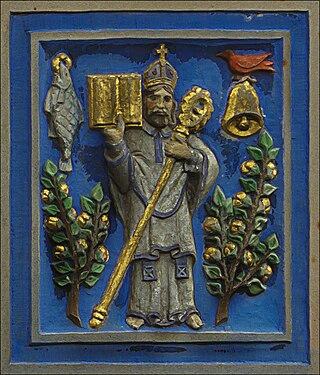
Kentigern, known as Mungo, was a missionary in the Brittonic Kingdom of Strathclyde in the late sixth century, and the founder and patron saint of the city of Glasgow.

Llangeitho is a village and community on the upper River Aeron in Ceredigion, Wales, about four miles west of Tregaron and 11 kilometres (7 mi) north of Lampeter. Its population of 874 in 2001 fell to 819 at the 2011 census.
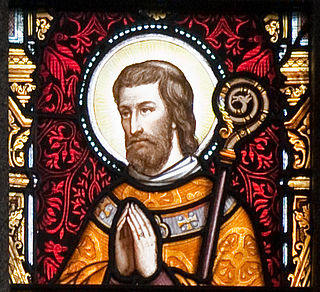
Saint Máedóc of Ferns, also known as Saint Aidan, Saint Madoc or Saint Mogue, was an Irish saint who was the first Bishop of Ferns in County Wexford and the founder of thirty churches. His birth name was Áed, the name of the Irish god of the underworld, meaning "fire". The name Aidan is a diminutive form of Aed or Aodh, and was also a form of the Latin name Dominus. Máedóc and Mogue are other pet forms of Aed or Aodh, formed from the Irish affectionate prefix mo- and the diminutive suffix -óg, meaning "young", making for something like "my dear little Aodh".

Llanddewi Brefi is a village, parish and community of approximately 500 people in Ceredigion, Wales. The village is notable for the famous Synod of Brefi held here in the sixth century. A number of miraculous events are said to have occurred during the synod, most notably by Saint David Welsh: Dewi Sant, patron saint of Wales. Today, it is one of the largest parishes in Wales and lies 7 miles (11 km) north-east of Lampeter between Tregaron and Llanfair Clydogau. It is in the electoral ward of Llangeitho.
The 1904–1905 Welsh revival was the largest Christian revival in Wales during the 20th century. It was one of the most dramatic in terms of its effect on the population, and triggered revivals in several other countries. The movement kept the churches of Wales filled for many years to come, seats being placed in the aisles in Mount Pleasant Baptist Church in Swansea for twenty years or so, for example. Meanwhile, the Awakening swept the rest of Britain, Scandinavia, parts of Europe, North America, the mission fields of India and the Orient, Africa and Latin America. The Welsh revival has been traced as the root of the megachurches in the present era.

Saint Cadoc or Cadog was a 5th–6th-century Abbot of Llancarfan, near Cowbridge in Glamorgan, Wales, a monastery famous from the era of the British church as a centre of learning, where Illtud spent the first period of his religious life under Cadoc's tutelage. Cadoc is credited with the establishment of many churches in Cornwall, Brittany, Dyfed and Scotland. He is known as Cattwg Ddoeth, "the Wise", and a large collection of his maxims and moral sayings were included in Volume III of the Myvyrian Archaiology. He is listed in the 2004 edition of the Roman Martyrology under 21 September. His Norman-era "Life" is a hagiography of importance to the case for the historicity of Arthur as one of seven saints' lives that mention Arthur independently of Geoffrey of Monmouth's Historia Regum Britanniae.
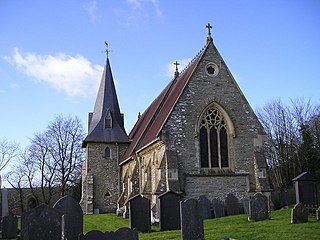
Saint Cynllo is a British saint, who lived in the late 5th and early 6th centuries, generally described as a brother of Saint Teilo. Cynllo was known for "...the sanctity of his life and the austerity of his manners."

Saint Cybi (Welsh), or Cuby (Cornish), was a 6th-century Cornish bishop, saint, and, briefly, king, who worked largely in Cornwall and North Wales: his biography is recorded in two slightly variant medieval 'lives'.

Dubricius or Dubric was a 6th-century British ecclesiastic venerated as a saint. He was the evangelist of Ergyng and much of south-east Wales.

Saint Oudoceus (Latin) or Euddogwy (Welsh) is generally known as the third Bishop of Llandaff in South Wales. In reality he was probably a 7th-century bishop at Llandeilo Fawr. Wendy Davies puts his episcopal reign between about 650 and 700.

Penygroes is a village in Gwynedd, Wales. The village is located to the south of Caernarfon, and north of Porthmadog, by the A487 road. Penygroes' population stands at 1,793 at the 2011 census, of which 88% are Welsh-speaking, making it one of the most predominantly Welsh-speaking areas of the country. The population of Llanllyfni community, which includes Penygroes and Llanllyfni village, which practically adjoins Penygroes, plus Talysarn, is 4,135 according to the 2011 census.

Llanllyfni is a village and a community in Gwynedd, Wales. It is in the historic county of Caernarfonshire. The community consists of the villages of Drws-y-coed, Nantlle, Nasareth, Nebo, Penygroes, Talysarn and the village of Llanllyfni itself. Penygroes, Llanllyfni and Talysarn are almost conjoined. As an electoral ward the 2011 census recorded a population of 1256. It is a largely Welsh-speaking village as 85% of the villagers speak Welsh as their first language. The community covers 43 square kilometres.
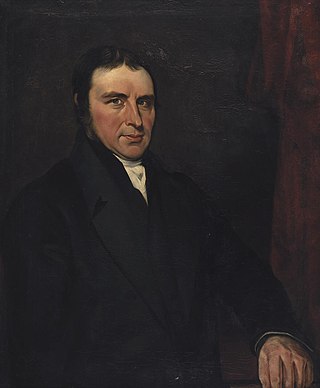
John Jones, Talysarn, was a Welsh Calvinistic Methodist minister, regarded as one of the greatest preachers in the history of Wales. Because the name "John Jones" was one of the most common in Wales at the time, he is usually differentiated by others of the same name by the use of the suffix "Talysarn", denoting the village where he lived.
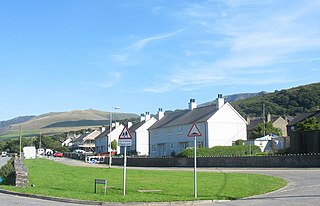
Tal-y-sarn is a village in the slate quarrying Nantlle Valley in Gwynedd, Wales, next to Penygroes. It is part of the community of Llanllyfni and includes some of Llandwrog. The ward had a population of 1,930 at the 2011 census, the built-up area having a population of 1,086.

Padarn was an early 6th century British Christian abbot-bishop who founded Saint Padarn's Church in Ceredigion, Wales. He appears to be the same individual as the first bishop of Braga and Saint Paternus of Avranches in Normandy. Padarn built a monastery in Vannes and is considered one of the seven founding saints of Brittany. His early vita is one of five insular and two Breton saints' lives that mention King Arthur independently of Geoffrey of Monmouth's Historia Regum Britanniae.
Derfel, known as Derfel Gadarn, was a 6th-century Celtic Christian monk regarded as a saint. Local legend holds that he was a warrior of King Arthur.
Nidan was a Welsh priest and, according to some sources, a bishop, in the 6th and 7th centuries. He is now commemorated as a saint. He was the confessor for the monastery headed by St Seiriol at Penmon, and established a church at what is now known as Llanidan, which are both places on the Welsh island of Anglesey. He is the patron saint of two churches in Anglesey: St Nidan's Church, Llanidan, built in the 19th century, and its medieval predecessor, the Old Church of St Nidan, Llanidan. Midmar Old Kirk in Aberdeenshire, Scotland, is also dedicated to him: Nidan is said to have helped to establish Christianity in that area as a companion of St Kentigern. St Nidan's, Llanidan, has a reliquary dating from the 14th or 16th century, which is said to house his relics.
Elaeth was a Christian king and poet in Britain in the 6th century who is venerated as a saint. After losing his territory in the north of Britain, he retreated to Anglesey, north Wales, where he lived at a monastery run by St Seiriol at Penmon. Some religious poetry is attributed to him, as is the foundation of St Eleth's Church, Amlwch, also in Anglesey.

The Diocese of Bangor is a diocese of the Church in Wales in North West Wales. The diocese covers Anglesey, most of Caernarfonshire and Merionethshire and the western part of Montgomeryshire.















